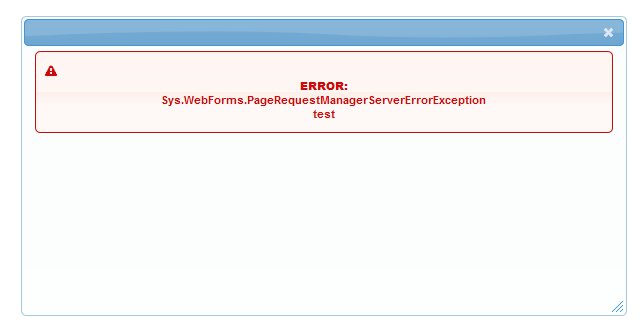Introduction
Yesterday, I wrote about issue with Ajax postbacks in an application I am working currently. The problem was with buttons that was triggering UpdatePanels to update asynchronously. After adding loading indicator, I wanted to add error handling at client side.
As loading was handled by PageRequestManager events, I was trying to achieve errors in the same way. At first, I created some HTML to show when error happens:
<div id="errorDialog" class="hidden">
<div class="ui-widget center height100per width100per">
<div class="ui-state-error ui-corner-all" style="padding: 0 .7em;">
<p>
<span class="ui-icon ui-icon-alert" style="float: left;
margin-right: .3em;"></span>
<strong>Error:</strong>
<br />
<span id="errorDesc"></span></p>
</div>
</div>
</div>
It creates Alert container from jQueryUI theme as you can see here. For me, it looks like this:

Styles are mostly from this library. My classes have meaningful names and are defined:
.width100per
{
width:100%;
}
.height100per
{
height:100%;
}
Folks at Microsoft do not add special event for errors in PageRequestManager, args argument of event handler for endRequest handler can tell as if something bad happened inside our application:
pageManager.add_endRequest(function (sender, args) {
if (args.get_error() != undefined) {
alert("Ouch!");
alert(args.get_error().message);
}
});
Now we have to just add some logic to show the error message inside our error container:
pageManager.add_endRequest(function (sender, args) {
if (args.get_error() != undefined) {
var errorMessage = args.get_error().message;
args.set_errorHandled(true);
jQuery('#errorDesc').html(htmlEncode(errorMessage).replace(":", "<br />"));
jQuery('#errorDialog').dialog({
width: 600,
height: 300
});
}
function htmlEncode(value) {
return jQuery('<div/>').text(value).html();
}
});
htmlEncode function replaces special HTML characters like < or > with HTML entities. It works by creating in-memory-only div element, and then setting some HTML as text and getting this as HTML. Simple as that. I added replacing : with HTML next line to show error description from C# in the below summary of exception. After that dialog is opening to show to user that something bad happens.

Dialog is much bigger than it needs to be, but I think that user must know that it's something serious and bigger message helps with that. 
That's all!
CodeProject
